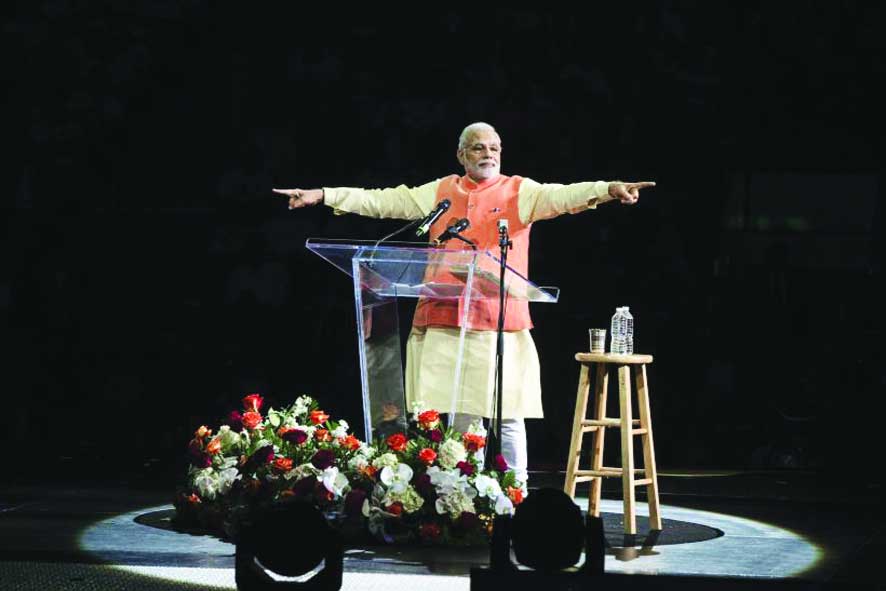While the Prime Minister’s critics allege that he is building brand Modi abroad, he feels that the power of global citizens should be harnessed for the growth of India as well as projecting a positive image in the US
Prime Minister Narendra Modi is all set to woo the Indian diaspora once again when he visits the United States (US) later this month to participate in the United Nations General Assembly meeting. Howdy Modi, a mega community summit that plays on the popular Texas greeting, is being planned in Houston on September 22. Modi is expected to address about 70,000 Indian-Americans in a show of popularity aimed at wowing Americans for the third time around.
The first was when he dazzled New York in 2014 during his Madison Square Garden rally with more than 40 American lawmakers by his side. “You play a key role in shaping a positive image of India not just in America but also around the world,” the Prime Minister told a rapturous crowd chanting “Modi, Modi” at the venue. The second was an equally big show in Silicon Valley in 2016, which was also a huge hit.
The Houston show is also significant as this will be the first in the US, after Modi got a huge mandate in the 2019 Lok Sabha polls. A known orator and showman, Modi will utilise this opportunity to connect directly with Indian-Americans and Non Resident Indians (NRIs). Texas, which is known as the energy capital of the world, has a special relationship with India as it is home to more than 300,000 Indians.
So the question is why is Modi investing so much in the Indian diaspora? For one, they play an important role in Modi’s politics and economics. He wants to mobilise the diaspora and use them to project a positive image of him in the US. He also wants to use this opportunity to further India’s business interests in that country.
As the Indian community has grown in influence, it is only natural for Modi to utilise it further. Even as Chief Minister of Gujarat, he knew its importance. Besides, while addressing them, Modi also targets his domestic constituency. The Indian diaspora is the second-biggest after China, with 30 million Indians living in 205 countries around the world.
Modi has made his interaction with Indians overseas a fundamental part of his foreign visits. In contrast, Jawaharlal Nehru, India’s first Prime Minister, pursued a policy of active dissociation from them. This continued until former Prime Minister PV Narasimha Rao realised the need for mobilisation of Indians abroad soon after kicking off liberalisation policies.
Modi is not the first to woo Indian Americans, as it was during the Vajpayee regime (1998-2004) that the lobby became quite influential and got American sanctions lifted after the Pokhran-II nuclear test and persuaded the then US President Bill Clinton to visit India in 2000.
Vajpayee, in his enthusiasm appointed Bhishma Agnihotri, an NRI as ambassador-at-large but Washington refused to recognise two ambassadors. Vajpayee was the first to organise Pravasi Bharatiya Divas to honour them for their contribution. Later, it was the diaspora’s influence that helped Manmohan Singh clinch the Indo-US nuclear deal in 2008.
The glitz and glamour surrounding Modi’s visit this month are part of a diplomacy drive, which is getting more and more refined. One of the main deviations from India’s traditional foreign policy is that Modi has instructed all Indian embassies to be receptive to the concerns of the community there.
Second, he has turned overseas Indians into an effective tool of his foreign policy, which is a key achievement. Modi has praised them and called them ambassadors of India and treats them as part of India’s soft power standing. He believes that Indian-Americans are one of the wealthiest and most educated communities in the US.
Third, even electorally, Indian-Americans have been useful to Modi. They raised money, provided technical services for his election campaigns, volunteered for mobilisation campaigns and lobbying. Moreover, by showing off his clout Modi also sends a signal to the US political parties about his extended vote bank.
Fourth, given his proposed meeting with Chief Executive Officers (CEOs) in Houston, he could also promote Indian business interests by seeking investment from American multinationals. To his credit, Modi has never lost a chance to promote Indian interests.
Moreover, the BJP has always been more active among Indians living abroad than the Congress. For decades now the Rashtriya Swayamsevak Sangh (RSS) and its constituents have been working in the US and elsewhere propagating Hindu culture and building temples. By contrast, the Congress has been slow in getting connected with Indian- Americans.
Why do Indians abroad look to Modi? It is because they trust him and hope he will turn India into a land of opportunities. They appreciate that Modi has given them many facilities like the Overseas Citizenship of India (OCI) card, making visas easier, voting by proxy and admission in schools etc. They are now demanding dual citizenship.
For Modi the diaspora is not a liability but an asset. While Modi’s critics allege that he is building brand Modi abroad, he feels that their power should be harnessed for the growth of India as well as his own image and he has succeeded in both so far.
(The writer is a senior journalist)


























